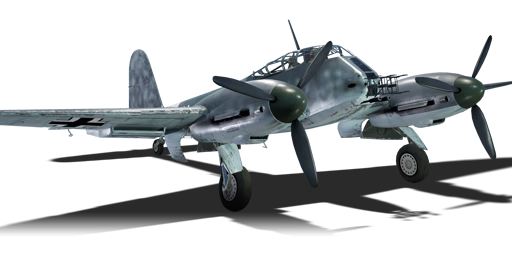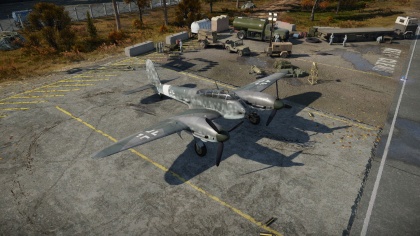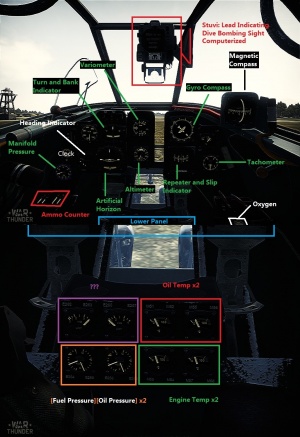Me 410 B-6/R3
Contents
| This page is about the German twin-engine fighter Me 410 B-6/R3. For other uses, see Me 410 (Family). |
Description
The Me 410 B-6/R3 is a Rank IV German twin-engine fighter
with a battle rating of 4.7 (AB), 5.0 (RB), and 5.3 (SB). It was in the game since the start of the Open Beta Test prior to Update 1.27.
General info
Flight Performance
Describe how the aircraft behaves in the air. Speed, manoeuvrability, acceleration and allowable loads - these are the most important characteristics of the vehicle.
| Characteristics | |||||||
|---|---|---|---|---|---|---|---|
| Stock | |||||||
| Max Speed (km/h at 6,900 m) |
Max altitude (meters) |
Turn time (seconds) |
Rate of climb (meters/second) |
Take-off run (meters) | |||
| AB | RB | AB | RB | AB | RB | ||
| 598 | 582 | 9800 | 32.2 | 33.2 | 8.1 | 8.1 | 520 |
| Upgraded | |||||||
| Max Speed (km/h at 6,900 m) |
Max altitude (meters) | Turn time (seconds) | Rate of climb (meters/second) |
Take-off run (meters) | |||
| AB | RB | AB | RB | AB | RB | ||
| 644 | 620 | 9800 | 29.9 | 31.0 | 14.0 | 10.8 | 520 |
Details
| Features | ||||
|---|---|---|---|---|
| Combat flap | Take-off flap | Landing flap | Air brakes | Arrestor gear |
| ✓ | ✓ | ✓ | ✓ | X |
| Limits | ||||
|---|---|---|---|---|
| Wing-break speed (km/h) |
Gear limit (km/h) |
Combat flap (km/h) |
Max Static G | |
| + | - | |||
| 750 | 350 | 480 | ~9 | ~4 |
| Optimal velocities | |||
|---|---|---|---|
| Ailerons (km/h) |
Rudder (km/h) |
Elevators (km/h) |
Radiator (km/h) |
| < 360 | < 360 | < 460 | > 265 |
| Compressor (RB/SB) | ||
|---|---|---|
| Setting 1 | ||
| Optimal altitude | 100% Engine power | WEP Engine power |
| 5,750 m | 3,120 hp | 3,551 hp |
Survivability and armour
- 8 mm steel - front of cockpit (either side of the glass)
- 5 mm steel - wings leading edge (in front of fuel tanks)
- 8 mm steel - prop hub and gear bay
- 9 mm steel - top and bottoms of wings (around the liquid cooling system
- 8 mm steel - plates in the tail
- 8 mm steel - bulkhead aft of gunner
- 8 mm steel - between gunner and pilot
- 12 mm steel - pilot's headrest
- 60 mm bulletproof glass - in front of the pilot (inside aircraft)
Armaments
Offensive armament
The Me 410 B-6/R3 is armed with:
- 2 x 30 mm MK 103 cannon, chin-mounted (120 rpg = 240 total)
- 2 x 20 mm MG 151/20 cannon, fuselage-mounted (350 rpg = 700 total)
Defensive armament
The Me 410 B-6/R3 is armed with:
- 1 x 13 mm MG 131 machine gun, 2 x beam turret (500 rpg = 1,000 total)
Usage in battles
The Me 410 B-6/R3, unlike its predecessors, has two 30 mm cannons in addition to the regular 20 mm cannons found on any Me 410, however, the 7.92 mm machine guns have been removed). With the HVAP-T upgrades, the 30 mm cannons make short work of light pillboxes, light and medium tanks, and even heavy tanks if hit on the side or back. Your primary goal should be unlocking the (Tier III) 30 mm ammunition belts. The "Hornisse" is most well suited for bomber hunting, due to its heavy armament. The aircraft can even use BnZ tactics against other aircraft provided if there is enough altitude. If you are planning to do aerial combat, be sure to side climb, as the 410's climb rate is far from superior to the Spitfires and Bearcats you will face. It is also equipped with airbrakes, which is quite unusual for an aircraft of its size and role. As with any plane, it is inadvisable to attack a bomber by sitting on its tail. It is advisable that you key-bind the 20 mm and 30 mm cannons separately if you are going for the CAS role it is well-suited for. Binding different buttons to fire the cannons separately can conserve a lot of ammo, which you can discriminate between which calibre to use when going after heavily-armoured or lightly-armoured targets. When choosing to go for the Intercept role, it is important (though you do not need too) that you cue the 30 mm and 20 mm together, as it will make much more of a difference in the 1-3 seconds worth of a good deflection.
Radars
The Me 410 B-6/R3 is equipped with a FuG 202 search radar, located in the nose of the aircraft; a control box which is part of the radar damage model is located behind the pilot.
| FuG 202 - Target Detection Radar | |||
|---|---|---|---|
| Maximum Detection Range |
Guaranteed Detection Range |
Max Azimuth Scan Angle |
Max Elevation Scan Angle |
| 4,000 m | 4,000 m | ±30° | ±30° |
Manual Engine Control
| MEC elements | ||||||
|---|---|---|---|---|---|---|
| Mixer | Pitch | Radiator | Supercharger | Turbocharger | ||
| Oil | Water | Type | ||||
| Not controllable | Controllable | Not controllable | Controllable | Combined | Not controllable | Not controllable |
Modules
| Tier | Flight performance | Survivability | Weaponry | ||
|---|---|---|---|---|---|
| I | Fuselage Repair | Radiator | Turret 13 mm | ||
| II | Compressor | Airframe | New 13 mm MGs (turret) | ||
| III | Wings Repair | Engine | Offensive 30 mm | Offensive 20 mm | |
| IV | Engine Injection | Cover | New 30 mm cannons | New 20 mm cannons | |
Pros and cons
Pros:
- Has access to a target detection radar
- Is equipped with airbrakes, allowing for tighter turns and steeper dive angles
- Devastating firepower, is able to rip through any aircraft or vehicle in a short burst
- Extremely versatile, can switch between CAP and CAS roles effectively
- Accelerates quite fast, especially in level flight
- Radiator and propeller spinner is covered with armour plating, covering the engine and radiator from hits
- Leading edges of the wing have armour plating
- The defensive armament consists of two 13 mm machine guns, which can effectively chew through any aircraft's engine block
- The rear turrets have excellent coverage, almost covering all attacks from the rear of the aircraft
- Tail gunner is difficult to hit from a level flight, he is also covered with a large armour plate
- Ammunition is plentiful, sometimes you don't run out
- Will cool down slowly even when the throttle is 100%
- Does not lose a significant amount of energy during manoeuvres
- Low-speed manoeuvring is impressive
- MK 103 cannon projectiles have a high muzzle velocity, and even higher with HVAP-T rounds, giving you a significant advantage in head-on engagements
- MK 103 cannons are capable of destroying light pillboxes by default, and light/medium tanks with HVAP-T rounds. Heavy tanks can also be destroyed, but require extremely precise aiming
Cons:
- Large target
- Limited pilot protection, the pilot's torso and chest areas are not protected by armour
- Rate of climb is impairing
- Enters compressibility all too often when reaching 350 mph (563 km/h)
- Lacks effective ground attack without 30mm HVAP
- No payload options
History
Describe the history of the creation and combat usage of the aircraft in more detail than in the introduction. If the historical reference turns out to be too big, take it to a separate article, taking a link to the article about the vehicle and adding a block "/ History" (example: https://wiki.warthunder.com/(Vehicle-name)/History) and add a link to it here using the main template. Be sure to reference text and sources by using <ref>, as well as adding them at the end of the article. This section may also include the vehicle's dev blog entry (if applicable) and the in-game encyclopedia description (under === Encyclopedia Info ===, also if applicable).
Media
Excellent additions to the article would be video guides, screenshots from the game, and photos.
See also
Links to the articles on the War Thunder Wiki that you think will be useful for the reader, for example:
- reference to the series of the aircraft;
- links to approximate analogues of other nations and research trees.
External links
Paste links to sources and external resources, such as:
- topic on the official game forum;
- encyclopedia page on the aircraft;
- other literature.
| Germany twin-engine fighters | |
|---|---|
| Messerschmitt | Bf 109 Z-1 |
| Me 410 A-1/U2 · Me 410 B-1/U2 | |
| Dornier | Do 17 Z-7 · Do 217 J-1 · Do 217 J-2 · Do 217 N-1 · Do 217 N-2 |
| Focke-Wulf | Ta 154 A-1 |
| Junkers | Ju 88 C-6 · Ju 388 J |






